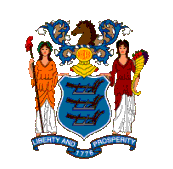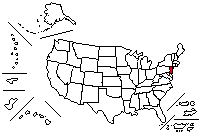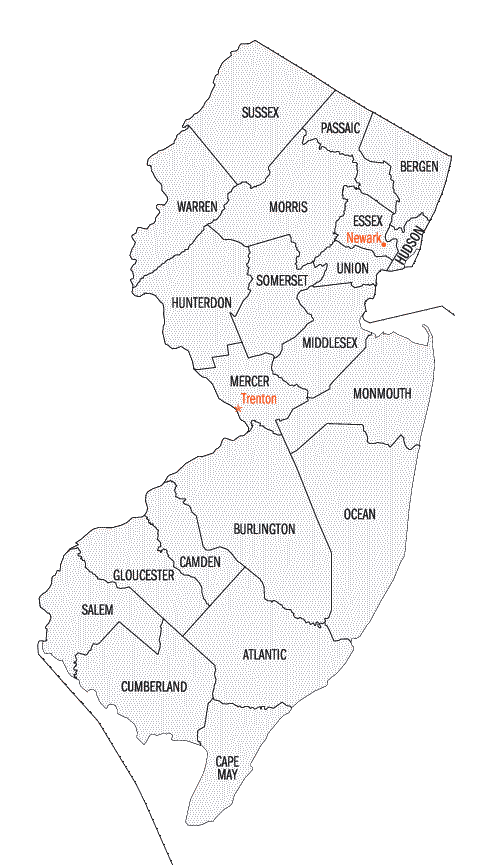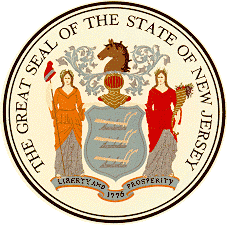
 |
|

















I'm From New Jersey
I'M FROM NEW JERSEY |
Soy de New Jersey Música y escrito por Red Mascara
soy DE NEW JERSEY y |


Flag:
On March 23rd, 1779 during the war of the Revolution, the Continental Congress, by resolution authorized and directed the Commander-in-Chief to prescribe the uniform, both as to color and facings, for the regiments of the New Jersey Continental Line. In accordance with this resolution, General Washington, in General Orders dated Army Headquarters, New Windsor, New York, October 2nd, 1779, directed that the coats for such regiments should be dark blue, faced with buff.
On February 28th, 1780, the Continental War Officers in Philadelphia directed that each of said regiments should have two flags, viz: one the United States flag and the other a State flag, the ground to be of the color of the facing. Thus the State flag of New Jersey became the beautiful and historic buff, as selected for it by the Father of His Country, and it was displayed in view of the combined French and American armies in the great culminating event of the War of the Revolution, the capitulation of a British army under Lieutenant General Earl Cornwallis at Yorktown.
The same color has been prescribed for the state flag of New York, where a law requires it to be displayed with the United States flag over the capital when the legislature is in session.
The inquiry arises, why did General Washington select the beautiful historic buff facings exclusively for the Continental lines of New York and New Jersey when such facings were only prescribed for his own uniform and that of other Continental general officers and their aides-de-camp?
He evidently made the selection not only designedly, but for historic reasons. New York and New Jersey had originally been settled by the Dutch. Dark blue (Jersey blue) and buff were Holland or Netherlands insignia.
The Governor as commander-in-chief represents the State of New Jersey, and should have a prescribed headquarters flag, different from that used by infantry, cavalry or artillery. In custom, every state Governor has one, but the propriety of an enactment on the subject is obvious.
The State flag of New Jersey is buff colored. The state coat of arms is emblazoned in the center. The shield has three plows with a horse's head above it. Two women represent the goddesses of Liberty and Agriculture. A ribbon at the bottom includes the year of independence in 1776 and reads: Liberty and Prosperity. The New Jersey state flag was formally adopted in 1896.
Bandera:
El 23 de marzo de 1779 durante la guerra de la revolución, el
congreso continental, por resolución autorizó y ordenó al
comandante en jefe a establecer el uniforme, en cuanto a color y
revestimientos, para los regimientos de la nueva línea continental de
Jersey. De acuerdo con esta resolución, general Washington, en las
órdenes generales fechadas en las jefaturas del ejército, New Windsor,
New York, del 2 de octubre de 1779, ordena que las capas para tales
regimientos deben ser azul marino, revestido con cuero.
El 20 de febrero de 1780, los oficiales continentales de la guerra en
Philadelphia decidieron que cada uno de los regimientos tuviera
dos banderas, viz: uno que los Estados Unidos
y el otro una bandera del estado, el fondo debía ser del
color de los revestimientos. Así la bandera del estado de New Jersey
se convirtió en la hermosa e historica piel, según
lo seleccionado por el padre de su país, y fue
exhibidas a los ejércitos franceses y americanos
combinados en el gran acontecimiento que culminaba de la guerra de la
revolución, la capitulación de un ejército británico bajo el
teniente general Earl Cornwallis en Yorktown.
El mismo color se ha establecido para la bandera del estado de New York,
en donde una ley requiere que sea expuesta con la bandera de
Estados Unidos en la capital cuando la legislatura esté en la
sesión.
Uno se pregunta el por qué el general Washington seleccionó
los revestimientos históricos
exclusivamente para las líneas continentales de New York y New Jersey
cuando tales revestimientos fueron establecidos solamente
para su propio uniforme y el de otros oficiales generales
continentales y de su socorro-de-campo? Evidentemente, él, hizo la
selección no solamente por su diseño sino por razones históricas.
New York y New Jersey habían sido establesidos originalmente por los
holandeses. Azul marino (azul de Jersey) y el color piel eran las
insignias de Holanda o de los Países Bajos.
El gobernador como comandante-en-jefe representa el estado de New Jersey,
y debe tener una bandera, diferente
de la usada por la infantería, la caballería o la artillería. En
costumbre, cada gobernador del estado tiene uno, pero la propiedad de
una promulgación en el tema es obvia.
La bandera del estado de New Jersey es de color piel.
El escudo de armas del estado se blasona en el centro. El escudo
tiene tres arados con la cabeza de un caballo sobre él. Dos mujeres
representan a las diosas de la libertad y de la agricultura. Una
cinta en el fondo incluye el año de la independencia en 1776 y lee:
Libertad y prosperidad. La bandera del estado de New Jersey fue
adoptada formalmente en 1896.

New Jersey
New Jersey (niú-yér-si en inglés) Nueva Jersey (en español).
Capital City: Trenton
National: New Jerseyans
Admission to Statehood: December 18, 1787
Border States: Delaware - New York - Pennsylvania.
Motto: Liberty and Prosperity.
The state had used this patriotic, hopeful motto informally for at least a century before it was officially adopted in 1928 along with a new design in the state seal.BR>
Origin of the name: Nameb by England based for the island of Jersey, one of the Channel Islands.
Nickname: Garden State.
Ciudad Capital: Trenton (se pronuncia trén-ton en inglés y español)
Gentilicio: Nujerseño (nu-yer-se-ño)
Estados Limítrofes: Delaware - New York - Pennsylvania.
Lema: Libertad y Prosperidad.
El estado ha utilizado este lema informalmente por lo menos un siglo antes de que fuera adoptado oficialmente en el 1928 en el nuevo diseño del sello estatal.
Origen del nombre: Nombre dado por Inglaterra basado en la isla de Jersey, una de las Islas del Canal.
Cognómento: El Estado Jardín.


The Seal:
The supporting female figures are Liberty and Ceres, the Roman goddess of grain, symbolizing abundance. Liberty, on the viewer's left, carries the liberty cap on her staff. Ceres holds a cornucopia filled with harvested produce.
Although the Seal's major elements have kept their relative positions for more than 200 years, there have been a number of lesser changes. The staff that Liberty now holds with her right hand she once held in the crook of her left arm. While the female figures now face straight ahead they at one time looked away from the shield. The cornucopia that Ceres now holds upright was once inverted, its open end upon the ground. The Seal was redesigned in accordance with Joint Resolution 8 of the Laws of 1928. It was then that the year of statehood, 1776, first appeared in Arabic figures.
Las figuras femeninas de soporte son la libertad y Ceres, la diosa
romana del grano, simbolizando abundancia. La libertad, en la
izquierda del espectador, lleva el casquillo de la libertad en un bastón. Ceres sostiene una cornucopia llenado de producto cosechado.
Aunque los elementos principales del sello han guardado sus posiciones
relativas por más de 200 años, ha habido un número de pequeños
cambios. El batón que la libertad ahora la sostiene con su mano
derecha estubo una vez sostenido en su brazo izquierdo. Mientras
que las mujeres que ahora miran hacia adelante anteriormente
miraban a lo lejos desde el escudo. El cornucopia que Ceres ahora lleva a
estubo invertido una vez, su extremo abierto estaba hacia la
tierra. El sello fue reajustado de acuerdo con la resolución conjunta
8 de los leyes de 1928. La fecha de la estadidad, 1776,
estubo, anteriormente escrito en figuras árabes.
New Jersey's state seal was designed by Pierre Eugene du Simitiere and presented in May 1777, to the Legislature, which was then meeting in the Indian King Tavern in Haddonfield. The three plows in the shield honor the state's agricultural tradition. The helmet above the shield faces forward, an attitude denoting sovereignty and thus particularly fitting for one of the first governments created under the notion that the state itself is the sovereign. The crest above the helmet is a horse's head.
El sello del estado de New Jersey fue diseñado por Pierre Eugene du
Simitiere y presentado en mayo de 1777, a la legislatura, que entonces
se reunia la taberna El Rey Indio en Haddonfield. Los tres arados en
el escudo honran la tradición agrícola del estado. El casco
sobre el escudo hacia adelante en una actitud que denota
soberanía y que es así particularmente para uno de los primeros
gobiernos creados bajo noción que el estado en sí mismo es el soberano.
La cresta sobre el casco es la cabeza de un caballo.

History
Named for the island of Jersey, one of the Channel Islands, New Jersey was the 3d of the 13 colonies to enter the Union. Its capital, Trenton, was the site of Washington's first decisive victory of the American Revolution in 1776.
The earliest inhabitants of the New Jersey area are believed to have lived in the region as early as the 11th century BC. The inhabitants at the time of European arrival were Lenni Lenape, or Delaware, Indians--farmers, fishers, and hunters of the Algonquian language group. Three linguistic groups lived in the area: the Munsee, the Unami, and the Unalachtigo. By the time the Europeans arrived, the Indians had established permanent villages. The major threat to those inhabitants, other than disease, came from the Iroquois to the north.
The area was claimed by the English, French, and Dutch on the basis of explorations (1524-1623) by Giovanni da Verrazano, Henry Hudson, and Cornelius Mey and on earlier exploration (1497) by John Cabot. The Dutch established New Netherland in what is now New York and New Jersey. The then-powerful Swedes established small settlements on the Delaware River; it is there that Swedish and Finnish settlers built what are thought to be the first log cabins in North America.
Cultural differences in trade and land-ownership practices created conflict, and the earliest Dutch settlements in New Jersey were destroyed during Indian attacks. In 1660, under the direction of Gov. Peter Stuyvesant, the fortified village of Bergen--present-day Jersey City--became the first permanent New Jersey settlement.
In 1664, England began to press colonial claims, and the name New Jersey was first used in a deed that gave the area to John, Lord Berkeley, and Sir George Carteret. Except for a brief return to Dutch rule in 1673, New Jersey remained British until the American Revolution. In 1676 the colony was divided from northwest to southeast into West New Jersey (Berkeley's portion) and East New Jersey (Carteret's portion). The boundary line was subsequently redrawn twice. Present-day county boundaries and private property lines suggest the final demarcation. West New Jersey, purchased by a group led by William Penn, served as a haven for persecuted English Quakers. East New Jersey attracted many New Englanders. These people, along with Dutch, Swedes, Scots, Irish, Germans, and French Huguenots, gave New Jersey greater cultural diversity than any other area. This lack of homogeneity contributed heavily--along with the initial division of the colony--to New Jersey's persistent lack of cohesiveness and identity. In 1702 the two proprietorships joined to form the royal colony of New Jersey.
During the colonial period industry began to grow in the Pine Barrens with the manufacture of iron and glass from local bog iron ores and sands. Iron was also produced in the northwest from local ores. Commerce was important, and New Jersey's highways were the best in the colonies because of its location between New York and Philadelphia and between the northern and southern colonies. Most of the people practiced subsistence agriculture, but specialization in truck crops began early near the New York and Philadelphia areas.
New Jersey's strategic location and cultural diversity created many hardships during the American Revolution. Individual loyalties based on economy, religion, and cultural heritages resulted in a bitter local civil war within the larger conflict. Both British and colonial armies occupied, plundered, and marched repeatedly across the region. The major battles of Trenton and Monmouth, along with many skirmishes, were fought in New Jersey. Washington's army spent two harsh winters at Morristown, protected from the British by the Watchung ridges to the east. For four months in 1783, because of a mutinous disturbance in Philadelphia, Princeton was the capital of the new country.
During the War of 1812 the need for rapid overland transport through the state resulted in road improvements that later provided routeways for railroads. Following the war large numbers of European immigrants arrived, swelling the populations of the state's cities. Although commerce remained the dominant economic sector until 1840, the state's industries expanded with increased demand and a growing labor force.
The sentiment of New Jersey's population was divided during the Civil War, with many people sympathetic to the Southern cause. The state did not support Abraham Lincoln in his reelection bid for the presidency in 1864 but cast its votes for George B. McClellan, a New Jersey Democrat.
During the 19th century, New Jersey gained attention as the location for significant inventions. John Stevens built the nation's first steam locomotive and the world's first steam ferry line in Hoboken during the early 1800s. Later in the century, Thomas Alva Edison set up his laboratory in New Jersey at Menlo Park and later at West Orange for work on the lightbulb, phonograph, and motion pictures. The state's research tradition has continued into the present day, with such developments as the telecommunications satellite in 1962 and the transistor in 1948.
Nombrado por la isla de Jersey, una de las islas del canal. New Jersey fue la tercera de las 13 colonias en entrar en la unión. Su
capital, Trenton, fue el sitio de la primera victoria decisiva de
Washington de la revolución americana en 1776.
La pesca inglesa y los establecimientos de intercambios comenzaron
(1623) en el "Odiorne's Point" -- cerca de la desembocadura
del Piscataqua -- y
algunos años más tarde en Hilton's Point (ahora Dover).
En 1629 los propietarios originales del área entre los ríos
Merrimack y Kennebec, Sir Ferdinando Gorges y el capitán
John Mason, dividieron el área entre ellos, Mason tomaba el sur
del área del Piscataqua, que él llamó Nuevo Hampshire. A partir el
1641 a 1679, y otra vez a partir el 1690 a 1692, los establecimientos
de Nueva Hampshire estubieron bajo jurisdicción de Massachusetts, y a
partir el 1699 a 1741, Nuevo Hampshire compartieron un gobernador real
con Massachusetts.
Se cree que los habitantes más cercanos al área de New Jersey pudo haber
vivido en la región desde el 11mo siglo A.CC.. Los habitantes en el momento de la llegada europea eran los indios Lenni Lenape, o Delaware, que eran
granjeros, pescadores, y cazadores del grupo los
Algonquianos. Tres grupos lingüísticos vivieron en el área: el
Munsee, el Unami y el Unalachtigo. Para el momento en que llegaran
los europeos, los indios habían establecido aldeas permanentes. La
amenaza principal para esos habitantes, con excepción de la
enfermedad, vino del Iroquois al norte.
El área fue reclamada por los ingleses, francesea y holandeses basandose a las exploraciones (1524-1623) por Giovanni da Verrazano, Henry Hudson, and Cornelius Mey
y en la exploración anterior
(1497) por Juan Cabot. Los holandeses fundaron Nueva Holanda el
cuál ahora es New York y New Jersey. Los, entonces, poderosos suecos establecieron pequeños asentamientos en el río
Delaware; es allí que los colonos suecos y finlandeses construyeron,
lo que se cree que fueron, las primeras barracas de registro en
Norteamérica.
Las diferencias culturales en las prácticas del comercio y de la propiedad de tierras entraron en conflictos, y los primeros asentamientos
holandeses de New Jersey fueron destruidos durante
ataques indios. En 1660, bajo dirección de Gov. Peter Stuyvesant, la
villa fortificada de Bergen la actual Ciudad de Jersey se convirtió
en el primer establecimiento permanente de New Jersey.
En 1664, Inglaterra comenzó a presionar su reclamos coloniales, y el nombre de
New Jersey fue utilizado por primera vez en unas escrituras del área que se le dio a Juan Lord Berkeley, and Sir George Carteret
. A
excepción de una breve retorno al régimen holandes en 1673, New Jersey seguía siendo británico hasta la revolución americana. En
1676 dividieron a la colonia desde noroeste a sureste en New Jersey
del oeste (porción de Berkeley) y New Jersey del este (porción de
Carteret). La línea limítrofes fue posteriormente cambiado dos
veces. Los límites actuales del condado y las privadas sugieren la demarcación final. New Jersey del
oeste, comprado por un grupo dirigido por William Penn, sirvió
como asilo para ingleses perseguidos. New Jersey del este
atrajo a muchos nuevos ingleses. Esta gente, junto con holandeses,
suecos, escoseses, irlandeses, alemanes y franceses, dieron a
New Jersey mayor diversidad cultural que cualquier otra área. Esta
falta de la homogeneidad contribuyó fuertemente -- junto con la
división inicial de la colonia -- a la nueva necesidad persistente de
Jersey de la cohesividad y de la identidad. En 1702 las dos
propiedades se unieron para formar la Real Colonia de New Jersey.
La nueva localización estratégica y la diversidad cultural de Jersey
crearon muchas dificultades durante la revolución americana. Las
lealtades individuales basadas en economía, la religión, y
patrimonios culturales dieron lugar a una amarga guerra civil local
dentro del conflicto más grande. Ambos ejércitos, británicos y coloniales,
ocuparon y marcharon en varias ocasiones a través de la
región. Las batallas principales de Trenton y de Monmouth, junto con
muchas escaramuzas, fueron luchadas en New Jersey. El ejército de
Washington pasó dos inviernos ásperos en Morristown, protegido
contra los Británicos por las cordilleras de Watchung al este. Por cuatro
meses en 1783, debido a unos motines en Philadelphia,
Princeton se convirtió en la capital del nuevo país. Durante la guerra de 1812
la necesidad de un rápido transporte por tierra a través del estado
dio lugar a las mejoras del camino que proporcionaron más tarde
las rutas para los ferrocarriles. Después de la guerra una gran
cantidad de inmigrantes europeos llegaron, aumentando las poblaciones
de las ciudades del estado. Aunque el comercio seguía siendo el
sector económico dominante hasta 1840, las industrias del estado se
ampliaron con demanda creciente y una mano de obra cada vez mayor.
El sentimiento de la población de New Jersey fue dividido durante
la guerra civil, con mucha gente comprensiva a la causa meridional.
El estado no apoyó a Abraham Lincoln en su reelección hecha una
oferta para la presidencia en 1864 sino echó sus votos para George B.
McClellan, demócrata de Jersey nueva.
Durante el siglo 19, New Jersey llamó la atención como el lugar de las
invenciones significativas. John Stevens construyó la primera
locomotora a vapor de la nación y la primera línea del
transbordador a vapor del mundo en Hoboken durante el 1800s.
Más adelante en el siglo, Thomas Alva Edison instaló su
laboratorio en New Jersey en el Menlo park y más tarde en West Orange
trabajo con la bombilla, el fonógrafo,
y las películas. La tradición de la investigación del estado ha
continuado hasta hoy, con los progresos tales como las telecomunicaciones
basadas en los satélites en 1962 y el transistor en 1948.
Historia
